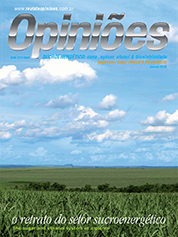Pedro Robério de Melo Nogueira
President of Sindaçúcar - Alagoas
Op-AA-25
Current scenario in the sugar and ethanol industry
The dynamics taking place in the Brazilian sugar-based energy industry in recent years has been caused by expectations of some, and the certainty of others, about the need to produce energy and consume it in a sustainable manner, i.e., without imposing risks on human life and the environment in which humans live, thereby basing itself on this existential harmony among production, its development, its efficiency, its use and the possibility of not adversely impacting the environment and the natural evolutionary cycle of living beings.
Energy resulting from this process is referred to as alterna-tive energy, in contrast to the energy which has consolidated over the centuries, based on fossil reserves made available by Nature. In recent times, this energy option – before accepted as merely supplementary – is in the process of being anchored to concepts of sustainable energy efficiency, social insertion and environmental self-sustainability.
The Brazilian capacity to produce sugarcane on a grand scale, in an economically competitive and sustainable manner, made us the host to the world’s largest space for such investment options. Domestic savings, accumulated over many years, started to be directed to the expansion of existing production units and the acquisition of some operational units, in what was a trend immediately followed by a large amount of funds allocated by industry-external institutional investors, both in the country and abroad, and sustained by strong support from the BNDES.
The increase in supply due to the significant increase in production predominantly resulted from the major allocation of capital by foreign investors, which started acquiring equity in companies and investing in the construction of new production units. In so far as this increase in supply was not matched by an equivalent increase in demand for ethanol, mainly from abroad, causing prices and company revenues to unwantedly decline, one could not observe a receding in investments that might have endangered the excellent opportunity to invest funds in this activity in Brazil, but only adaptations to investment time schedules and to the start-up of new industrial units.
Concurrently, in the last two harvest seasons, we learned the lesson - forgotten at times -, that the supply of energy resulting from green biomass requires special attention when one goes about quantifying it, since one must take into account climate influence, either as a reducer or enhancer of such energy. This relentless reality stands out.
In a first moment, because of the abundant supply and the nonconfirmation of the favorable option for ethanol from abroad, to the foreseen extent. In a second moment, a natural adjustment resulting from the lack of supply of final products due to the influence of the climate takes place, quite normal in agricultural activities.
All this in combination with the impressive increase in the domestic ethanol market as a consequence of the consolidation of dual-fuel vehicles as an option for Brazilian consumers and the unrestricted use of ethanol as fuel in such vehicles. Hence, in the past five years, what we saw happening in a very clear manner, were all these trends towards expansion in the Brazilian sugar-based energy industry and we could corroborate realities that will greatly contribute to the industry’s development:
a. major domestic expansion of production units in operation;
b. vigorous inflow of capital through institutional investors, allowing for the speedy expansion of supply, also with respect to newly installed industrial plants;
c. major participation by the official development bank in expansion financing, notably to increase the supply of co-generated energy from sugarcane bagasse;
d. hence, through all this, the confirmation of our local capacity to respond and the feasibility of expanding supply in an economically viable and sustainable manner;
e. the observation that foreign markets for ethanol are progressively being opened at a slow pace, be that due to the removal of inhibiting entry tariffs or due to the progressive awareness of the importance of using low carbon content fuel, friendlier to the environment;
f. planning supply, taking into account not only projects, but also a stringent assessment of the climatic possibility for agricultural production, the industrial processing capacity of such actual supply and the actual industrial yield that is transformed into available industrial products; and,
g. finally, the consistent growth of domestic demand, as asserted by the growing consumption of ethanol in dual-fuel cars.
From now on, the following considerations and certainties will remain: the use of ethanol as alternative fuel - to high carbon content alternative is unavoidable, also considering our privileged participation in technological production innovation in new production technology generations; the newly installed projects will, from now on, have to seek production efficiency, at times neglected when intensive expansion is in progress; the balance between supply and demand of electric energy requires an institutional model that, in a long-lasting and effective manner, obtains energy co-generated from sugarcane bagasse and improves Brazilian per capita income, while also assuring that in some countries sugar will continue to grow in a sustainable manner, even in light of high competitiveness from Brazil, given current stable price levels and the potential of genetic research to obtain new sugarcane varieties with better economic results. The decision now is to optimize the implemented projects to achieve efficiency and the increase in productivity aiming at the new expansion cycle.




